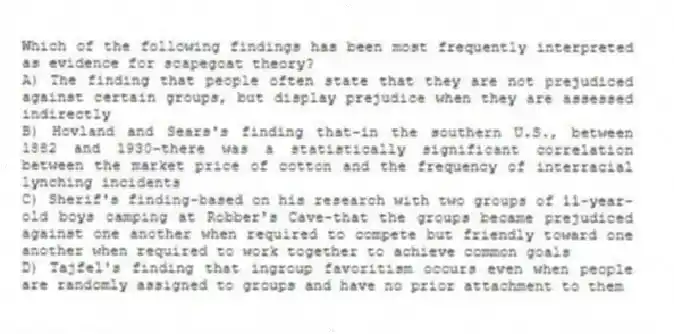
Which of the following findings has been most frequently interpreted as evidence for scapegoat theory?
A) The finding that people often state that they are not prejudiced against certain groups, but display prejudice when they are assessed indirectly
B) Hovland and Sears's finding that-in the southern U.S., between 1882 and 1930-there was a statistically significant correlation between the market price of cotton and the frequency of interracial lynching incidents
C) Sherif's finding-based on his research with two groups of 11-year-old boys camping at Robber's Cave-that the groups became prejudiced against one another when required to compete but friendly toward one another when required to work together to achieve common goals
D) Tajfel's finding that ingroup favoritism occurs even when people are randomly assigned to groups and have no prior attachment to them
Correct Answer:
Verified
Q83: When you meet a new person, stereotypes
Q106: As described in the textbook, scapegoat theory
Q107: Scapegoat theory proposes that _.
A) people are
Q108: Researchers Darley and Gross (1983) showed different
Q109: In a well-known study using archival data,
Q110: You have been set up on a
Q112: Which of the following statements BEST summarizes
Q113: As described in the text, the self-serving
Q114: Let's assume that most high school students
Q116: Ingrid holds the stereotype that girls who
Unlock this Answer For Free Now!
View this answer and more for free by performing one of the following actions

Scan the QR code to install the App and get 2 free unlocks

Unlock quizzes for free by uploading documents